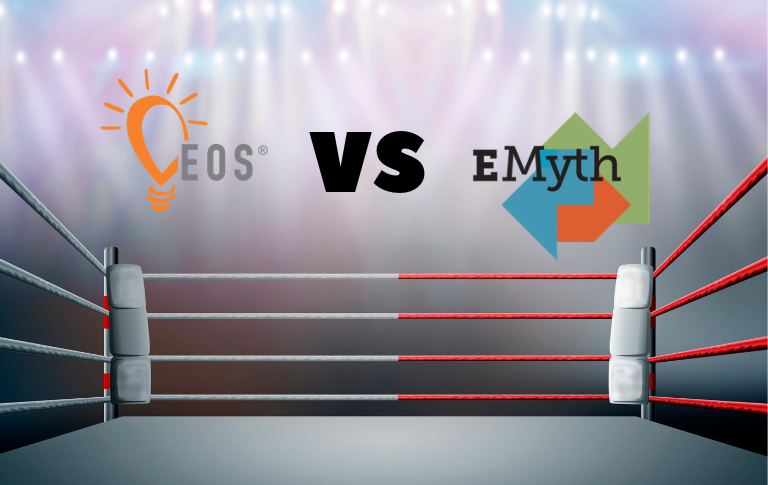At the beginning of every year there is a slew of annual planning templates made available from various consulting and coaching firms promoting their services. But not all annual planning templates are created equal. Their various questions and topics are designed to get you to think about different strategies and tactics you can embrace for the following year.
Planning for the future is an activity all businesses and organizations should be doing on an annual basis. It helps you to create clarity for the next 12 months.
At Way We Do, we recommend you set a recurring task and create processes to complete your annual plan each year. You will need to enlist the help of your leadership team, and you may also want input from your employees or even an external facilitator.
We’ve recently received some annual planning templates from EOS (the Entrepreneurial Operating System) and E-Myth, so we thought it would be good to compare the two, and hopefully help you decide which one will suit your business best.
Downloadable Annual Planning Templates
Both organizations provide their annual planning templates in a PDF downloadable file available from their respective websites.
EOS’s template is called “The Vision Traction/Organizer”. In addition to it being a PDF template, it is available for download as a Word document that you can edit directly. You can also seek assistance from a professional EOS Implementer to help you prepare it.
Unfortunately, E-Myth’s “Your Annual Plan 2019” template is only available as a PDF. If you’re a pen-and-paper type of person, this will be fine and handy. However, more of us are favoring digital versions these days, so we can minimize re-typing and share it more easily with our teams.
Core Values
The Vision/Traction Organizer is based on the hub-and-spoke EOS model, with focus on vision, data, process, people, issues, and traction. The template is divided into two sections–Vision, and Traction–over two pages, keeping the planning process simple.
The first section, Vision, starts by focusing on Core Values. Knowing your core values as an organization is vital, as they’ll guide your decision-making throughout the year. EOS Worldwide’s blog gives a few examples of core values.
- Everyone is a team player.
- A can-do attitude.
- We always want to learn and improve.
- Provide great customer service.
- We are reliable.
- Always do the right thing.
In contrast, the E-Myth planning template doesn’t focus as much on core values. Instead, it puts the question, “Are you in touch with your values and company mission to ensure you create a business that is personally satisfying and reflects your needs and aspirations?”
At Way We Do, we believe reinforcing a business’s core values is a critical part of the planning process. They provide the foundation of the objectives, strategies and tactics you create that flow out of your plan and into your business; tactics that may not otherwise adopt the same principles if not for a values-based framework.
Core Focus
As the name implies, “Core Focus” helps you to create focus, so you’re less tempted to be distracted by the newest shiny trend or sparkly technology that may come your way through the course of the year. Without a clearly defined focus, it’s very easy to get caught up in emerging ideas and spread yourself too thin pursuing them.
Core Focus hones in on two key areas: Purpose, Cause and Passion and Niche. These areas ask questions like, “What gets you out of the bed in the morning?”, “Is your team inspired to work in your company each and every day?”, and “What is your mission?”
In 2009, Simon Sinek shared with the world via a TED talk the power and science of finding and understanding your “why”.
“Achievement happens when we pursue and attain what we want. Success comes when we are in clear pursuit of why we want it. As the Zen Buddhist saying goes, how you do anything is how you do everything. Working hard for something we don’t care about is called stress; working hard for something we love is called passion.”
Simon Sinek
Your “Niche” is the one thing your company truly excels in and can be the best in the world at. Niche defines the “what” in the “what you do”. If you try to be all things to all people, ultimately you’re a master of none.
What is the one thing in the world your company is best at?
The E-Myth Annual Plan template doesn’t get you to find your niche or reinforce your why.
10-Year Target
In traditional business planning processes, a “10-Year Target” is akin to a “Vision Statement”. Vision statements are future-based to inspire and give direction to the company and those who work in it.
While E-Myth alludes to “Vision” in action item examples, it’s not included as part of the annual planning process. It assumes the purpose statement and company values are already set. For example,
“Quarter 1 Goal: Leadership and Management: Become a more inspirational leader and implement key management systems throughout the company.
January Action Goals: Recommit to my Purpose Statement and company values and vision; Develop process for employee engagement in company values, vision.”
Marketing Strategy
Both methodologies have a focus on marketing strategy. E-Myth asks a series of questions pertaining to marketing and sales. It includes questions relating to lead generation, marketing channels, the impact of your marketing messages, social media, proven sales conversion processes, sales goals and referral systems.
In contrast, EOS asks basic questions regarding target market, your unique selling proposition (USP), proven processes and guarantees.
3-Year Picture
The next section on the EOS Vision page is the 3-Year Picture, including revenue, profit, and measurables. Often what you do in Year 1 impacts what you do in Years 2 and 3. E-Myth’s annual plan focuses on the coming year only.
Get Stuff Done
With both annual plan templates, there is a focus on achieving goals for the following year. Page 2 of the EOS Vision/Traction Organizer helps you map out a one-year plan, identify your “rocks”, and build a list of potential issues. EMyth’s primary focus is on listing quarterly goals and monthly action items, as well assigning accountability to people within the organization, and due dates.
Both EOS and E-Myth emphasize the importance of reviewing your plans regularly. E-Myth incorporates the review process within the Annual Plan. In comparison, EOS endorses a very specific meeting process that continually monitors the objectives a business owner sets out in their Vision/Traction Organizer.
Which One Will You Choose?
EOS and E-Myth annual planning templates and corresponding processes each have their strengths and weaknesses.
The strength of E-Myth’s template is that it asks plenty of questions to help managers consider each area of their business and where they can improve in the following year. The downside is its apparent design as a solitary exercise for the business owner or founder, rather than a collaborative process involving the leadership team and staff members.
The strength of the EOS Vision/Traction Organizer is in how it helps leadership teams create more focus and align action points with the company’s broader vision. EOS recommends a one- to two-day, off-site meeting with the whole team to involve them in the planning process. Another effective aspect of this template is how it helps teams consider the issues that may get in the way of their accomplishing the “big rocks” for the year. After all, there’s no use planning action items if there are issues that will stop the business achieving them. They need to be resolved if you want to get stuff done.
We’d love to get your thoughts about the annual planning templates you use in your business. Are they similar to EOS and E-Myth’s approach? Or are there other aspects management teams should be considering when planning objectives, strategies and tactics each year? Do you have regular annual review and planning processes in place for your business? Or is it a more ad hoc affair? 2019 is still young, so maybe now is the time to get started.
If you’d like help or advice with setting up your planning processes in Way We Do, get in touch with us at support@waywedo.com. We can also introduce you to external facilitators who can assist you with offsite planning sessions.
We’re here to help you succeed!





